LEAN PROJECTS MANAGEMENT LEADING LEADING LEAN PROJECT Name of the University Author
Added on 2023-04-23
24 Pages4008 Words473 Views
Running head: LEAN PROJECT MANAGEMENT
LEADING LEAN PROJECT
Name of the Student
Name of the University
Author Note:
LEADING LEAN PROJECT
Name of the Student
Name of the University
Author Note:
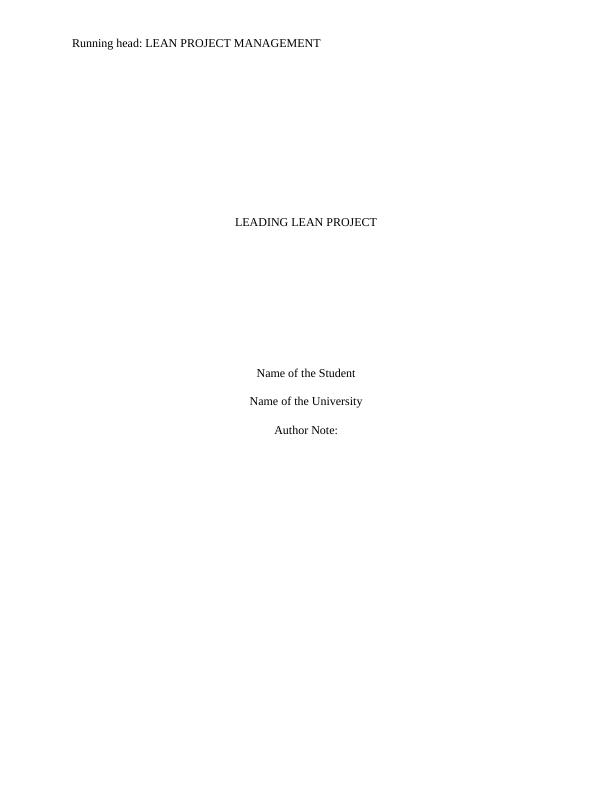
2
LEAN PROJECTS MANAGEMENT
Table of Contents
1 Introduction...................................................................................................................................3
2 Problem Identification..................................................................................................................4
2.1 Histogram..............................................................................................................................4
2.2 Pareto chart............................................................................................................................5
2.3 Check sheet............................................................................................................................5
2.4 Control Activity.....................................................................................................................5
2.5 Fishbone Diagram..................................................................................................................6
2.6 Scatter Plot Diagram..............................................................................................................6
2.7 Chart Title..............................................................................................................................6
2.8 Stratification..........................................................................................................................7
3 Plan of Risk Management.............................................................................................................8
3.1 Risk Register..........................................................................................................................8
3.2 Qualitative / Quantitative Risk Analysis...............................................................................9
3.3 Risk Response......................................................................................................................10
3.4 Risk responses implementation...........................................................................................11
3.5 Monitoring of risk responses...............................................................................................12
4 Leadership style appropriate to bring about the change.............................................................12
4.1 Laissez –Faire......................................................................................................................12
4.2 Transactional........................................................................................................................12
4.3 Servant Leader.....................................................................................................................13
4.4 Transformational Leaders....................................................................................................13
4.5 Interactional Leaders...........................................................................................................13
4.6 Charismatic Leaders............................................................................................................14
6. Reference...................................................................................................................................15
7 Appendix.....................................................................................................................................18
7.1 Histogram............................................................................................................................18
7.2 Pareto chart..........................................................................................................................19
7.3 Check sheet..........................................................................................................................19
7.4 Control Activity...................................................................................................................20
7.5 Fishbone Diagram................................................................................................................21
7.6 Scatter Plat diagram.............................................................................................................22
7.7 Chart Title............................................................................................................................23
7.8 Stratification........................................................................................................................24
LEAN PROJECTS MANAGEMENT
Table of Contents
1 Introduction...................................................................................................................................3
2 Problem Identification..................................................................................................................4
2.1 Histogram..............................................................................................................................4
2.2 Pareto chart............................................................................................................................5
2.3 Check sheet............................................................................................................................5
2.4 Control Activity.....................................................................................................................5
2.5 Fishbone Diagram..................................................................................................................6
2.6 Scatter Plot Diagram..............................................................................................................6
2.7 Chart Title..............................................................................................................................6
2.8 Stratification..........................................................................................................................7
3 Plan of Risk Management.............................................................................................................8
3.1 Risk Register..........................................................................................................................8
3.2 Qualitative / Quantitative Risk Analysis...............................................................................9
3.3 Risk Response......................................................................................................................10
3.4 Risk responses implementation...........................................................................................11
3.5 Monitoring of risk responses...............................................................................................12
4 Leadership style appropriate to bring about the change.............................................................12
4.1 Laissez –Faire......................................................................................................................12
4.2 Transactional........................................................................................................................12
4.3 Servant Leader.....................................................................................................................13
4.4 Transformational Leaders....................................................................................................13
4.5 Interactional Leaders...........................................................................................................13
4.6 Charismatic Leaders............................................................................................................14
6. Reference...................................................................................................................................15
7 Appendix.....................................................................................................................................18
7.1 Histogram............................................................................................................................18
7.2 Pareto chart..........................................................................................................................19
7.3 Check sheet..........................................................................................................................19
7.4 Control Activity...................................................................................................................20
7.5 Fishbone Diagram................................................................................................................21
7.6 Scatter Plat diagram.............................................................................................................22
7.7 Chart Title............................................................................................................................23
7.8 Stratification........................................................................................................................24
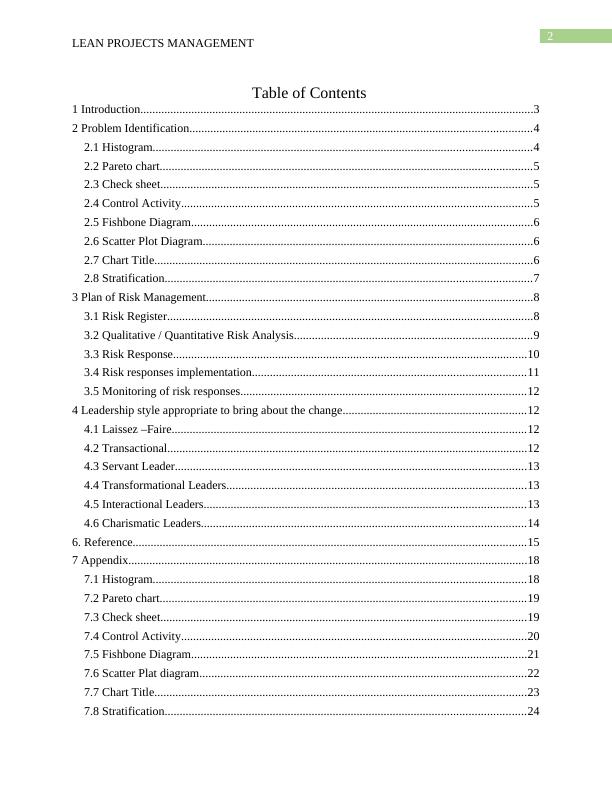
3
LEAN PROJECTS MANAGEMENT
1 Introduction:
The paper will be assisting the senior management team of Australian Engineering Works
Private Limited (AEW) as they are facing serious challenges from the emergence of new
suppliers and emergence of new business organizations as a result the consumers of this industry
now have more options, some of the consumers are opting for better products from the new
organization. The other challenge faced by the senior management team of AEW is the risks
coming from the senior employees as they were joining the new players of the same industry
(Furterer, 2016). AEW has been facing a decrease in net profit due to the discussed challenges.
This paper will be finding the root cause of this issue with the help of specific tools such as the
histogram, pareto chart, fish bone diagram, scatter plot diagram, why technique, Chart title
diagram, check sheet, control activity diagram and stratification table. Each of the above
discussed tools have their own signification in understanding the impact of the different types of
risks faced by this business organization (Brioso, 2015). The problem identification unit is
followed by the risk management plan consisting of the risk registers stating the impact of each
of the discussed risk associated with the organization. It is followed by the qualitative risk
analysis and risk response plan where the contingency plan will be discussed briefly (Orzen &
Bell, 2016). The monitoring of the risk is also mentioned in the paper.
The various leadership qualities which can have their impact in the working environment
of AEW will be stated in the paper in a descriptive manner such as the charismatic leaders,
transformational; leaders, interactional leaders, servant leaders, transactional leaders and Laissez
Faire style leaders (Ansah, Sorooshian & Mustafa, 2016). The appropriate leadership style
required to mitigate the risks found in AEW will be also mentioned in the paper. Thus, from this
unit of the paper we understand the importance of the risks which are being faced by AEW
(Kliem, 2015). The paper will also highlight the root causes of the risks with the help of tools
such as Pareto chart, Scatter Plat diagram, Chart Title, 5 Why technique, Fish one diagram,
stratification and check sheet.
LEAN PROJECTS MANAGEMENT
1 Introduction:
The paper will be assisting the senior management team of Australian Engineering Works
Private Limited (AEW) as they are facing serious challenges from the emergence of new
suppliers and emergence of new business organizations as a result the consumers of this industry
now have more options, some of the consumers are opting for better products from the new
organization. The other challenge faced by the senior management team of AEW is the risks
coming from the senior employees as they were joining the new players of the same industry
(Furterer, 2016). AEW has been facing a decrease in net profit due to the discussed challenges.
This paper will be finding the root cause of this issue with the help of specific tools such as the
histogram, pareto chart, fish bone diagram, scatter plot diagram, why technique, Chart title
diagram, check sheet, control activity diagram and stratification table. Each of the above
discussed tools have their own signification in understanding the impact of the different types of
risks faced by this business organization (Brioso, 2015). The problem identification unit is
followed by the risk management plan consisting of the risk registers stating the impact of each
of the discussed risk associated with the organization. It is followed by the qualitative risk
analysis and risk response plan where the contingency plan will be discussed briefly (Orzen &
Bell, 2016). The monitoring of the risk is also mentioned in the paper.
The various leadership qualities which can have their impact in the working environment
of AEW will be stated in the paper in a descriptive manner such as the charismatic leaders,
transformational; leaders, interactional leaders, servant leaders, transactional leaders and Laissez
Faire style leaders (Ansah, Sorooshian & Mustafa, 2016). The appropriate leadership style
required to mitigate the risks found in AEW will be also mentioned in the paper. Thus, from this
unit of the paper we understand the importance of the risks which are being faced by AEW
(Kliem, 2015). The paper will also highlight the root causes of the risks with the help of tools
such as Pareto chart, Scatter Plat diagram, Chart Title, 5 Why technique, Fish one diagram,
stratification and check sheet.
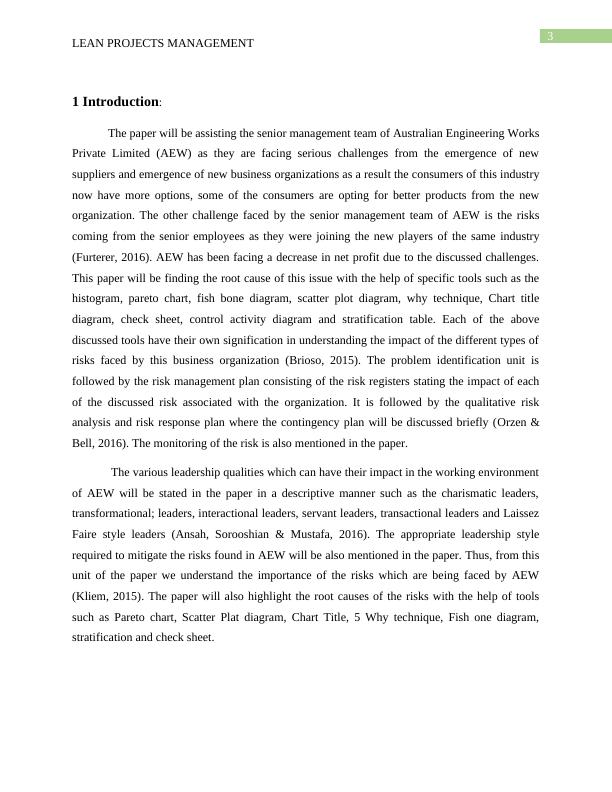
4
LEAN PROJECTS MANAGEMENT
2 Problem Identification:
A list of project management tools will be used to find the root cause of the issues faced
by Australian Engineering Works Private Limited.
2.1 Histogram
The histogram helps in understanding how each of the risk are examined with the help of
the variables of the risks and the interval between each of the risks The distribution of the risks is
also identified in the histogram (Özdemir, 2016). The arrival time and frequency of the risks
faced by AEW are considered in this tool. Apart from finding the main risk from a series of risk
it also highlights the importance of mitigating the other significant risks.
2.2 Pareto chart
The pareto chart is also defined as a type of histogram used to understand the impact of a
specific risk among a series of risks. The pareto chart diagram helps in understanding the impact
of each of the risks and the ultimate conclusion for these adverse situation (Cleophas &
Zwinderman, 2015). The threats from the market competition is the most vital threat according to
the pareto chart and it is followed by the other threats like employee retention and threats from
the emergence of new suppliers. The frequency of the challenge is stated in the diagram.
2.3 Check sheet
The check sheet diagram helps in understanding the 4 defects which are the main cause
behind the decrease in net profitability along with the importance which has to be given to each
of them based on marks out of 5 (Douglas, 2018). The defects which are the most vital will be
presented in the table. The check sheet helps in understanding that the market competition and
the threat coming from the new suppliers are the most essential risks which has to be mitigated
as soon as possible.
LEAN PROJECTS MANAGEMENT
2 Problem Identification:
A list of project management tools will be used to find the root cause of the issues faced
by Australian Engineering Works Private Limited.
2.1 Histogram
The histogram helps in understanding how each of the risk are examined with the help of
the variables of the risks and the interval between each of the risks The distribution of the risks is
also identified in the histogram (Özdemir, 2016). The arrival time and frequency of the risks
faced by AEW are considered in this tool. Apart from finding the main risk from a series of risk
it also highlights the importance of mitigating the other significant risks.
2.2 Pareto chart
The pareto chart is also defined as a type of histogram used to understand the impact of a
specific risk among a series of risks. The pareto chart diagram helps in understanding the impact
of each of the risks and the ultimate conclusion for these adverse situation (Cleophas &
Zwinderman, 2015). The threats from the market competition is the most vital threat according to
the pareto chart and it is followed by the other threats like employee retention and threats from
the emergence of new suppliers. The frequency of the challenge is stated in the diagram.
2.3 Check sheet
The check sheet diagram helps in understanding the 4 defects which are the main cause
behind the decrease in net profitability along with the importance which has to be given to each
of them based on marks out of 5 (Douglas, 2018). The defects which are the most vital will be
presented in the table. The check sheet helps in understanding that the market competition and
the threat coming from the new suppliers are the most essential risks which has to be mitigated
as soon as possible.
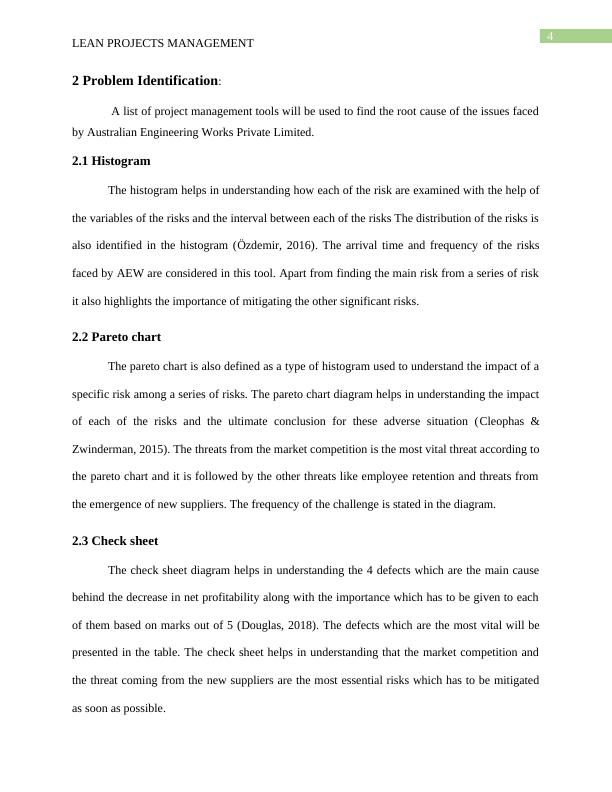
5
LEAN PROJECTS MANAGEMENT
2.4 Control Activity
The impact of controlling the four different categories of risks are considered while
created the control activity diagram. The time taken by the risks are also mentioned in the
diagram. The limits of the risks are also mentioned in the diagram (Koehler, 2017). The threat
from the consumer opting for new options are considered in this diagram.
2.5 Fishbone Diagram
The fishbone diagram helps in understanding the root causes behind the failure of the
organization. Each impact associated with the cause are stated in the paper. The issue of senior
employee retention has been selected are analysed using the concepts of the fishbone diagram.
Each probable reasons behind the senior employees joining new players are examined and
diagram is created accordingly.
2.6 Scatter Plot Diagram
The scatter plot diagram helps in understanding the increasing impact of the four reasons
behind the downfall of AEW. The impact of each of the risks may be different from each time.
Two variable are plotted in the X-axis (Visveshwar et al., 2017). According to the given scatter
plot diagram it can be said that the threats coming from the clients of this organization opting for
new substitute products and the emergence of the new similar organization are the twi main risks
of AEW.
2.7 Chart Title
The chart title of this assignment helps in understanding the different impact of the four
discussed risks such as the market competition, threat from substitute products, inefficient
employee turnover and ineffective business strategy. The threat from the substitute products have
LEAN PROJECTS MANAGEMENT
2.4 Control Activity
The impact of controlling the four different categories of risks are considered while
created the control activity diagram. The time taken by the risks are also mentioned in the
diagram. The limits of the risks are also mentioned in the diagram (Koehler, 2017). The threat
from the consumer opting for new options are considered in this diagram.
2.5 Fishbone Diagram
The fishbone diagram helps in understanding the root causes behind the failure of the
organization. Each impact associated with the cause are stated in the paper. The issue of senior
employee retention has been selected are analysed using the concepts of the fishbone diagram.
Each probable reasons behind the senior employees joining new players are examined and
diagram is created accordingly.
2.6 Scatter Plot Diagram
The scatter plot diagram helps in understanding the increasing impact of the four reasons
behind the downfall of AEW. The impact of each of the risks may be different from each time.
Two variable are plotted in the X-axis (Visveshwar et al., 2017). According to the given scatter
plot diagram it can be said that the threats coming from the clients of this organization opting for
new substitute products and the emergence of the new similar organization are the twi main risks
of AEW.
2.7 Chart Title
The chart title of this assignment helps in understanding the different impact of the four
discussed risks such as the market competition, threat from substitute products, inefficient
employee turnover and ineffective business strategy. The threat from the substitute products have
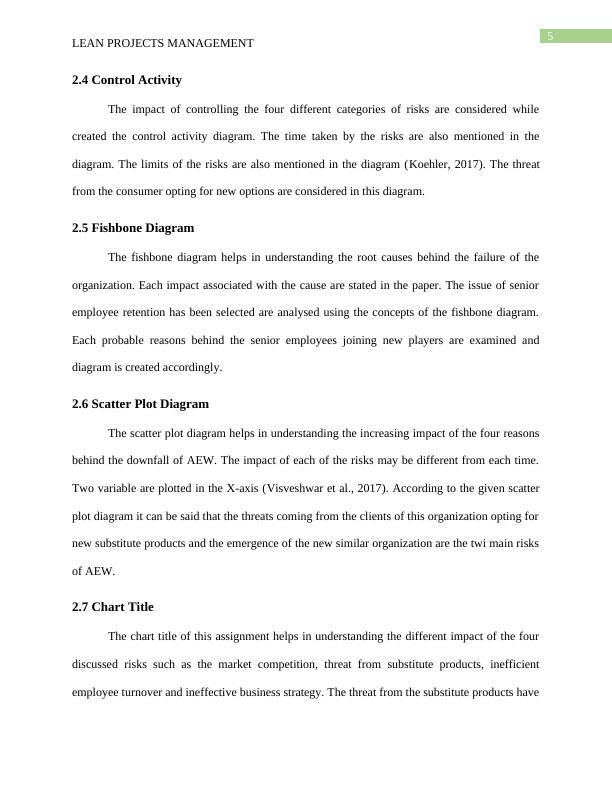
6
LEAN PROJECTS MANAGEMENT
maximum impact on the profitability (Akpolat, 2017). From the chart title we can understand
that the tough market competition and the threats coming from the consumers using alternative
products are the main risks associated with AEW.
2.8 Stratification
The stratification pyramid helps in understanding the importance of the risks which have
maximum impact on the business loss suffered by this business organization, it was found that
the lack of innovative powers is the primary reason behind the failure. Lack of business
strategies and no efficient recruitment procedure can be the other two reasons (Tupa, Simota, &
Steiner, 2017). The lack of innovative products and the inefficient business strategies are the two
main cause behind the downfall of AEW. The stratification pyramid also helps us understanding
that business organizations must have professional recruitment system and appraisal process so
that the resources of the company can be utilised for longer period of time.
5 Why’s technique
The 5 Why technique is defined as the type of technique which are used for investigation
purposes. According to this investigation technique it can be said that the problems for which the
net profitability of AEW has decreased can be identified with the help of the 5 questions. This
tools can be very much useful to analyse the problems faced by business organizations
(Matthews, Yousefi & Kuncheva (2018). The probable questions which can be useful to
understand the root cause of the problem are as follows:
What is the existing market position of AEW among the similar organization?
Which stakeholders are responsible for the business loss?
What is the root causes of the risks faced by AEW?
LEAN PROJECTS MANAGEMENT
maximum impact on the profitability (Akpolat, 2017). From the chart title we can understand
that the tough market competition and the threats coming from the consumers using alternative
products are the main risks associated with AEW.
2.8 Stratification
The stratification pyramid helps in understanding the importance of the risks which have
maximum impact on the business loss suffered by this business organization, it was found that
the lack of innovative powers is the primary reason behind the failure. Lack of business
strategies and no efficient recruitment procedure can be the other two reasons (Tupa, Simota, &
Steiner, 2017). The lack of innovative products and the inefficient business strategies are the two
main cause behind the downfall of AEW. The stratification pyramid also helps us understanding
that business organizations must have professional recruitment system and appraisal process so
that the resources of the company can be utilised for longer period of time.
5 Why’s technique
The 5 Why technique is defined as the type of technique which are used for investigation
purposes. According to this investigation technique it can be said that the problems for which the
net profitability of AEW has decreased can be identified with the help of the 5 questions. This
tools can be very much useful to analyse the problems faced by business organizations
(Matthews, Yousefi & Kuncheva (2018). The probable questions which can be useful to
understand the root cause of the problem are as follows:
What is the existing market position of AEW among the similar organization?
Which stakeholders are responsible for the business loss?
What is the root causes of the risks faced by AEW?
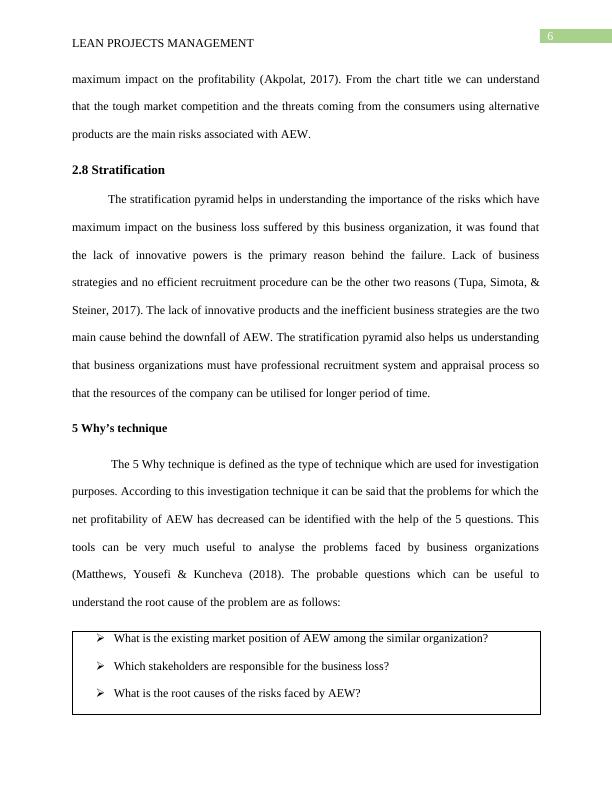
End of preview
Want to access all the pages? Upload your documents or become a member.
Related Documents
Lean Projects Management for Australian Engineering Works Private Limitedlg...
|22
|4624
|403
Leading Lean Projectslg...
|24
|3273
|252
PPMP20009 Leading Lean Projects - Home Buildinglg...
|22
|4261
|13
LEADING LEAN PROJECT.lg...
|20
|3338
|66
PPMP20009 Leading Lean Projects Assignment 2022lg...
|12
|3686
|8
